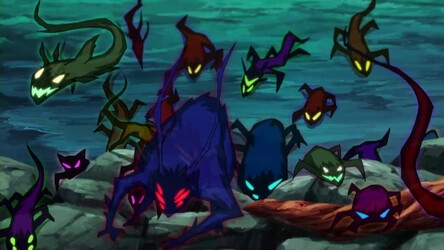Okay, here’s a brief description of the system that I’ve worked out over the past 10 years of D&D worldbuilding. We start with the classic four elements, but I’m referring to these rather as “essences” for the sake of clarity: the current names for these essences are Stone, Sky, Heat, and Flow. Everything in existence, then, contains 0 to 4 of these Essences, and its nature is determined by which combination is present (in quantities sufficient to matter; if you have 97% Stone and 1% each of the other three, you count as Earth-elemental regardless of the fact that you’re not technically pure, in the way an actual Elemental from the Earth Plane would be). Any being which is almost entirely composed of a single Essence is therefore representative of the corresponding classic Element.
A being which is roughly half Stone and half Heat is elemental to neither Fire nor Earth, but rather to Metal, while one which is half Stone and half Flow is elemental to Wood. Likewise, half Sky and half Heat is elemental to Lightning, and combining Sky with Flow produces neither Air nor Water, but the combination element of the two. This is one of several elements I’ve had trouble finding a perfectly fitting name for, but out of convenience I call it Thunder, representing Sonic damage, although a more precise name would be Wave or Pressure, as it represents any compression force that travels through a largely-fluid medium.
The “opposite” element pairs, Stone/Sky and Heat/Flow, are harder to explain, so I’ll come back to them in a minute; first we must look at the elements which are made up of three Essences, and thus are essentially the opposite of the element which is made up of the omitted Essence. The glaringly obvious example, and pretty much the reason I ever needed to have more than four elements in the first place, is Cold, the opposite of Fire; this is therefore obviously formed by having roughly equal amounts of Sky, Stone, and Flow while being almost completely absent of Heat.
The second most obvious of these “anti-elements”, by a fairly considerable distance, is anti-Water, composed of Earth, Air, and Fire (or rather of Stone, Sky, and Heat - you see why I made up these additional terms). I call this element Sand, which makes intuitive sense for now, and that’s the most important part, even if it’s going to cause us some problems later. This is basically the element of anything you would imagine finding in a desert (excluding technical deserts like Antarctica) - blisteringly hot sun, wind-blown sand that can cut you to ribbons, air too hot to breathe, ground that shifts beneath your feet, and of course a constant parching dryness.
Third of these anti-elements is anti-Earth, or Spirit, which is the element I was thinking about when I made this thread. As the combination of Sky, Heat, and Flow, it is quite well represented by a swirling semi-liquid mass of smoke, or by a congealed sort of gel which is alive with energy. But just as Earth is the most mundane and material of the elements, its opposite corresponds to a substance which doesn’t physically exist, and can only interact with the world through the exertion of magical force that reaches from “beyond the veil”, affecting the normal world only in places which are particularly transmundane, such as sacred ritual sites.
The hardest to define was anti-Air, the combination of Heat, Stone, and Flow. I sort of gave up and used this slot to insert something that I’ve long wanted an Elemental-type plane for in my D&D campaign, despite not really being able to work out which Element it should be; Fire and Water seemed to correspond at the very least, but Earth was hard to rule out, and it wasn’t clearly obvious that Air should be excluded either. However, ultimately I think of air as tending to be a crisp and refreshing force, something very light and dynamic and…well, airy, and this element is very much not any of that, so while it might generally need to consume small-a Air in order to live, it does seem at least loosely fitting as elementally aversive to big-a Air. This element, then, is Flesh, the element which corresponds to animal tissue as Wood does to plant tissue of any sort (calling the element Wood rather than Plant is largely a matter of good branding; the former simply sounds more appropriately mystical, and the same applies here).
That then brings us back to the last two pairings, which had a lot of issues. The easier of the two for me to understand, despite all the scientific imprecision involved, is an element I’m currently calling Glass, which is also symbolically very indicative of Time (I wouldn’t call Time an element myself, for the same reason that I wouldn’t call Light and Dark elements in the sense I use the term; if nothing else, D&D gives us Energy Planes for Positive and Negative Energy which map very well to Light and Darkness, and there’s an optional third such plane called Temporal Energy, which likewise matches Time…I also invented an opposite for that one, but that’s another story). The reason this element bugs the crap of me is that Glass is made of Air/Sky and Earth/Stone, and if you add Heat/Fire to Glass it then turns into Sand, which is the opposite of how that actually works. I’m considering changing one of these names to Dust in order to clarify the distinction, but I haven’t figured out which one; regardless, the fact that the “time” element can literally be symbolized by a glass hourglass full of sand, but is elemental to Glass and not to Sand (and also not to Metal, which is probably part of what a mechanical hourglass is made of)…this is one of the flaws in my theory.
A much bigger issue comes in with the Heat/Flow element that I roundaboutly alluded to before; one of the few reasons I haven’t entirely given up on this one is that, in D&D, there are Elemental Princes as major setting antagonists associated with all four of the classic elements, as well as a Cold-aligned one, Cryonax (the classic four have much more random names which don’t really correspond to their element at all, other than debatably the water one, Olhydra). And this element is the only one that I have not only conceptualized an Elemental Prince for, but even given that creature a name: Chemnox. The name of the element itself, however, is proving harder to pin down, because it is an element of “highly reactive chemicals”, which would fully include both flammable liquids like petroleum and also corrosive acids or bases, each of which fits the Fire/Water concept for different reasons. I recently learned that the word “volatile” doesn’t mean what I thought it was, so I’m even more hard up for appropriate descriptors of this Element than I was; currently my placeholder term is “petrol”, which has an appropriately fantastic sound, but entirely fails to describe the acid/alkali half of the element. As far as I can tell, the only actual commonality between inflammables and caustics is that both contain highly unstable hydrogen-oxygen molecule groups, so I’ve strongly debated giving the element a name like “Hydroxyl”, despite this being about as un-Fantasy as you can get…because the only thing worse than being un-Fantasy would be un-Element, and IMO “acid” qualifies for that issue. So for now I’m accepting “petrol” as the placeholder name, but this is the second biggest issue I still need to resolve before I’m completely satisfied with this system.
And that’s all the pairs and trios, leaving us with just two elements left. The element of having no Sky, no Stone, no Heat and no Flow is easily conceptualized, although the resulting term doesn’t work in SOTM: Void. (Where it works perfectly, and most of my inspiration for the term, is in Legend of the Five Rings, which uses only five elements in its Japanese-inspired mysticism, based not on the five Chinese elements which would replace Air with Wood and Metal, but rather in Miyamoto Musashi’s slight expansion upon what were either directly or coincidentally the same four elements which the Greeks talked about.) A much trickier question is what you get when you combine all four elements, other than “everything”, since in theory most of the universe consists not of Elementals of any kind, but rather of normal substances which contain all four elements in roughly equal quantities, so it’s hard to conceptualize an Element which is not a normal substance but still has all the parts of Creation within itself. Spirit is one of the more obvious candidates, but I’ve already used it elsewhere, and so I had to make up an only-kinda-different answer, which I’m moderately proud of, but which is also the single biggest gap in my theory at this point (the various other issues that still remain, apart from a proper name for Chemnox’s element, are minor enough that I’ve given up fighting about them). This solution was to call this final element “Maya”, a term lifted from Hindu philosophy, and to say that this element is the Grand Illusion which permeates the entire cosmos, preventing the truth of reality from being accurately understood. A mage who commands the Maya element is by definition an illusionist, or what the SCP Foundation calls a “reality bender”; their powers would be similar to what Thanos does with the Reality Stone in Infinity War, altering the appearance of things in scientifically impossible ways, but leaving no lasting effects once the illusion is broken.
There, that’s my entire element system as it currently stands, and I don’t see it getting a lot better without losing the aspects which I consider most essential to my own satisfaction with it.

